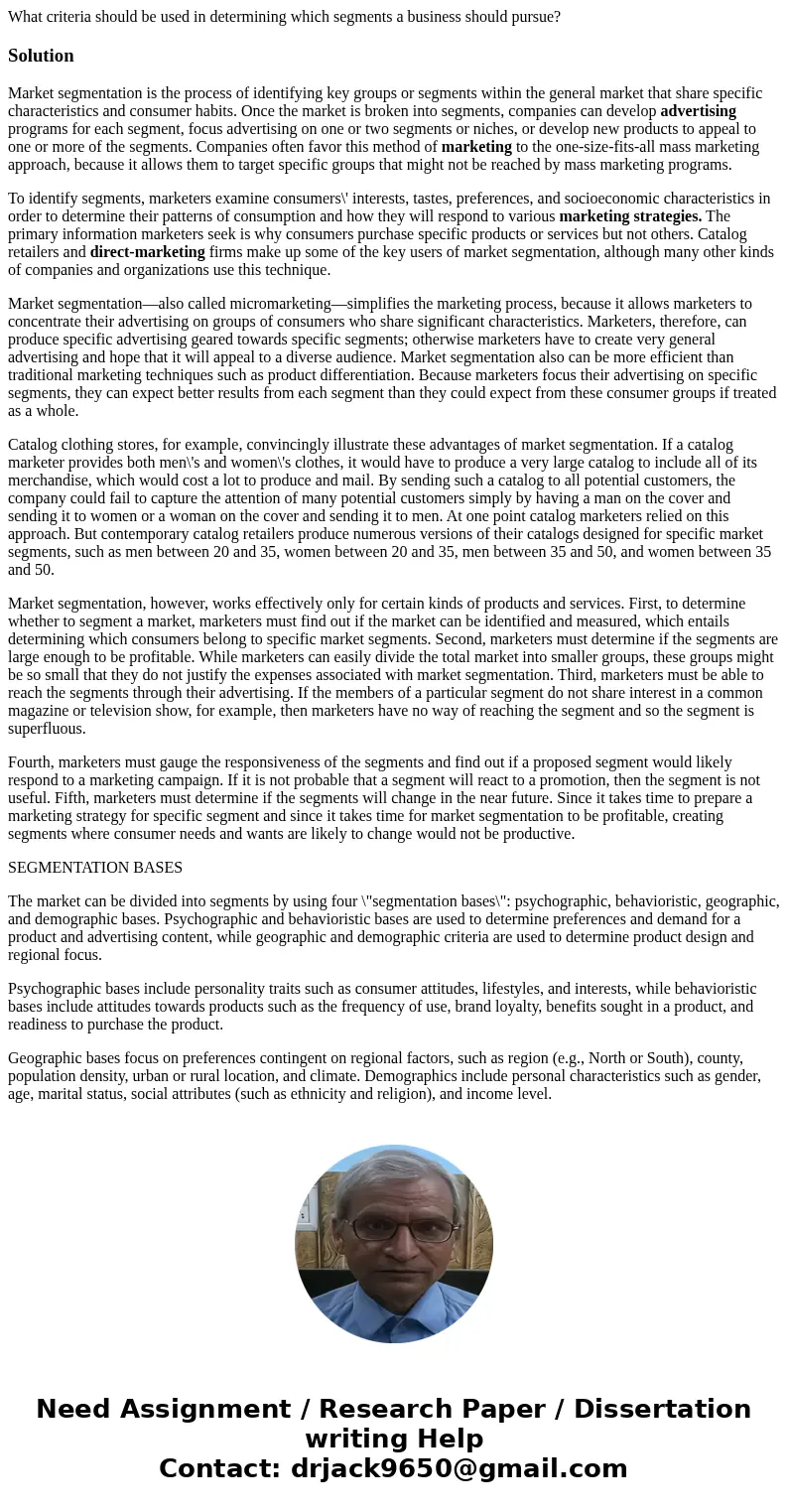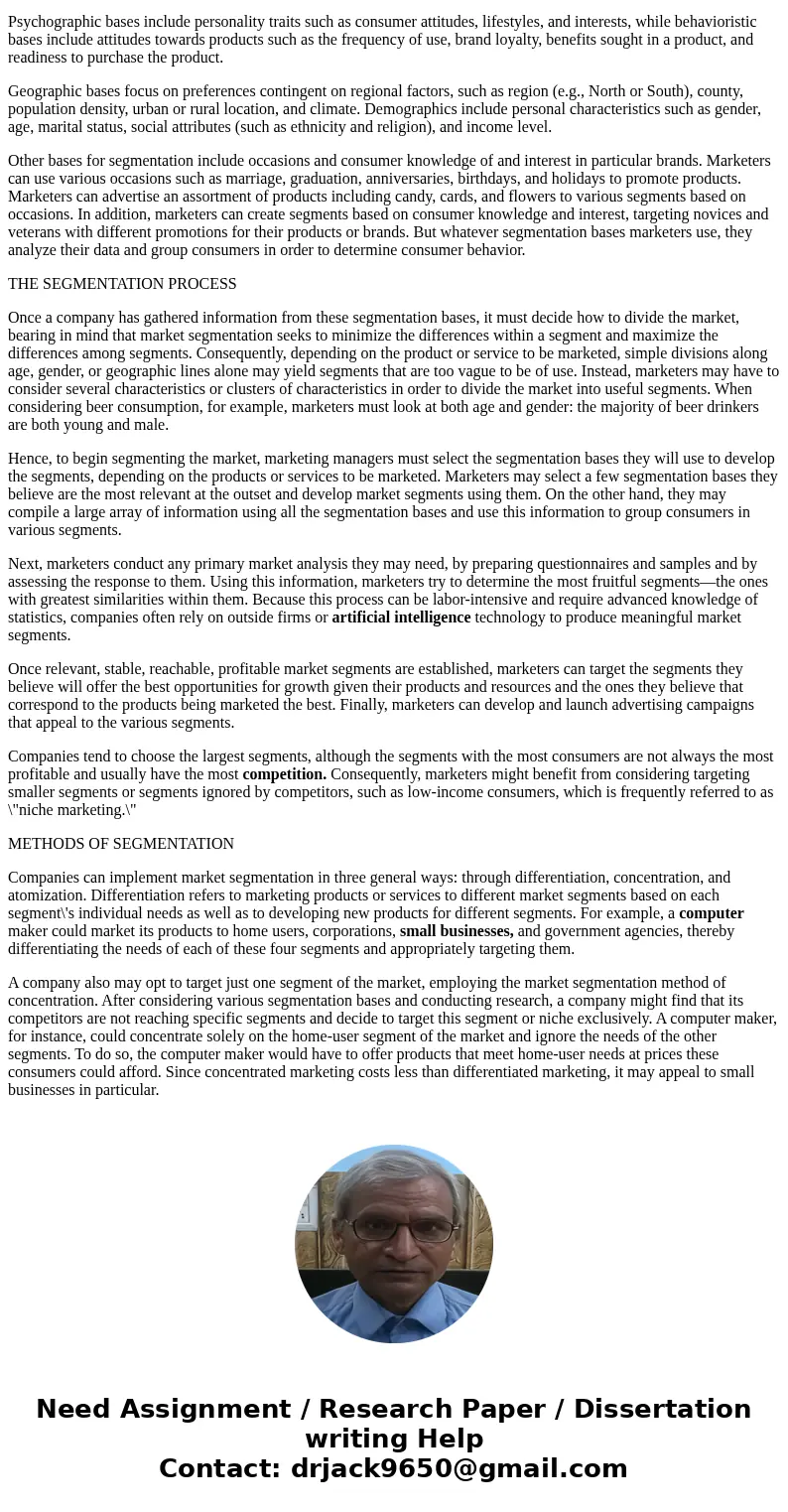What criteria should be used in determining which segments a
What criteria should be used in determining which segments a business should pursue?
Solution
Market segmentation is the process of identifying key groups or segments within the general market that share specific characteristics and consumer habits. Once the market is broken into segments, companies can develop advertising programs for each segment, focus advertising on one or two segments or niches, or develop new products to appeal to one or more of the segments. Companies often favor this method of marketing to the one-size-fits-all mass marketing approach, because it allows them to target specific groups that might not be reached by mass marketing programs.
To identify segments, marketers examine consumers\' interests, tastes, preferences, and socioeconomic characteristics in order to determine their patterns of consumption and how they will respond to various marketing strategies. The primary information marketers seek is why consumers purchase specific products or services but not others. Catalog retailers and direct-marketing firms make up some of the key users of market segmentation, although many other kinds of companies and organizations use this technique.
Market segmentation—also called micromarketing—simplifies the marketing process, because it allows marketers to concentrate their advertising on groups of consumers who share significant characteristics. Marketers, therefore, can produce specific advertising geared towards specific segments; otherwise marketers have to create very general advertising and hope that it will appeal to a diverse audience. Market segmentation also can be more efficient than traditional marketing techniques such as product differentiation. Because marketers focus their advertising on specific segments, they can expect better results from each segment than they could expect from these consumer groups if treated as a whole.
Catalog clothing stores, for example, convincingly illustrate these advantages of market segmentation. If a catalog marketer provides both men\'s and women\'s clothes, it would have to produce a very large catalog to include all of its merchandise, which would cost a lot to produce and mail. By sending such a catalog to all potential customers, the company could fail to capture the attention of many potential customers simply by having a man on the cover and sending it to women or a woman on the cover and sending it to men. At one point catalog marketers relied on this approach. But contemporary catalog retailers produce numerous versions of their catalogs designed for specific market segments, such as men between 20 and 35, women between 20 and 35, men between 35 and 50, and women between 35 and 50.
Market segmentation, however, works effectively only for certain kinds of products and services. First, to determine whether to segment a market, marketers must find out if the market can be identified and measured, which entails determining which consumers belong to specific market segments. Second, marketers must determine if the segments are large enough to be profitable. While marketers can easily divide the total market into smaller groups, these groups might be so small that they do not justify the expenses associated with market segmentation. Third, marketers must be able to reach the segments through their advertising. If the members of a particular segment do not share interest in a common magazine or television show, for example, then marketers have no way of reaching the segment and so the segment is superfluous.
Fourth, marketers must gauge the responsiveness of the segments and find out if a proposed segment would likely respond to a marketing campaign. If it is not probable that a segment will react to a promotion, then the segment is not useful. Fifth, marketers must determine if the segments will change in the near future. Since it takes time to prepare a marketing strategy for specific segment and since it takes time for market segmentation to be profitable, creating segments where consumer needs and wants are likely to change would not be productive.
SEGMENTATION BASES
The market can be divided into segments by using four \"segmentation bases\": psychographic, behavioristic, geographic, and demographic bases. Psychographic and behavioristic bases are used to determine preferences and demand for a product and advertising content, while geographic and demographic criteria are used to determine product design and regional focus.
Psychographic bases include personality traits such as consumer attitudes, lifestyles, and interests, while behavioristic bases include attitudes towards products such as the frequency of use, brand loyalty, benefits sought in a product, and readiness to purchase the product.
Geographic bases focus on preferences contingent on regional factors, such as region (e.g., North or South), county, population density, urban or rural location, and climate. Demographics include personal characteristics such as gender, age, marital status, social attributes (such as ethnicity and religion), and income level.
Other bases for segmentation include occasions and consumer knowledge of and interest in particular brands. Marketers can use various occasions such as marriage, graduation, anniversaries, birthdays, and holidays to promote products. Marketers can advertise an assortment of products including candy, cards, and flowers to various segments based on occasions. In addition, marketers can create segments based on consumer knowledge and interest, targeting novices and veterans with different promotions for their products or brands. But whatever segmentation bases marketers use, they analyze their data and group consumers in order to determine consumer behavior.
THE SEGMENTATION PROCESS
Once a company has gathered information from these segmentation bases, it must decide how to divide the market, bearing in mind that market segmentation seeks to minimize the differences within a segment and maximize the differences among segments. Consequently, depending on the product or service to be marketed, simple divisions along age, gender, or geographic lines alone may yield segments that are too vague to be of use. Instead, marketers may have to consider several characteristics or clusters of characteristics in order to divide the market into useful segments. When considering beer consumption, for example, marketers must look at both age and gender: the majority of beer drinkers are both young and male.
Hence, to begin segmenting the market, marketing managers must select the segmentation bases they will use to develop the segments, depending on the products or services to be marketed. Marketers may select a few segmentation bases they believe are the most relevant at the outset and develop market segments using them. On the other hand, they may compile a large array of information using all the segmentation bases and use this information to group consumers in various segments.
Next, marketers conduct any primary market analysis they may need, by preparing questionnaires and samples and by assessing the response to them. Using this information, marketers try to determine the most fruitful segments—the ones with greatest similarities within them. Because this process can be labor-intensive and require advanced knowledge of statistics, companies often rely on outside firms or artificial intelligence technology to produce meaningful market segments.
Once relevant, stable, reachable, profitable market segments are established, marketers can target the segments they believe will offer the best opportunities for growth given their products and resources and the ones they believe that correspond to the products being marketed the best. Finally, marketers can develop and launch advertising campaigns that appeal to the various segments.
Companies tend to choose the largest segments, although the segments with the most consumers are not always the most profitable and usually have the most competition. Consequently, marketers might benefit from considering targeting smaller segments or segments ignored by competitors, such as low-income consumers, which is frequently referred to as \"niche marketing.\"
METHODS OF SEGMENTATION
Companies can implement market segmentation in three general ways: through differentiation, concentration, and atomization. Differentiation refers to marketing products or services to different market segments based on each segment\'s individual needs as well as to developing new products for different segments. For example, a computer maker could market its products to home users, corporations, small businesses, and government agencies, thereby differentiating the needs of each of these four segments and appropriately targeting them.
A company also may opt to target just one segment of the market, employing the market segmentation method of concentration. After considering various segmentation bases and conducting research, a company might find that its competitors are not reaching specific segments and decide to target this segment or niche exclusively. A computer maker, for instance, could concentrate solely on the home-user segment of the market and ignore the needs of the other segments. To do so, the computer maker would have to offer products that meet home-user needs at prices these consumers could afford. Since concentrated marketing costs less than differentiated marketing, it may appeal to small businesses in particular.


 Homework Sourse
Homework Sourse